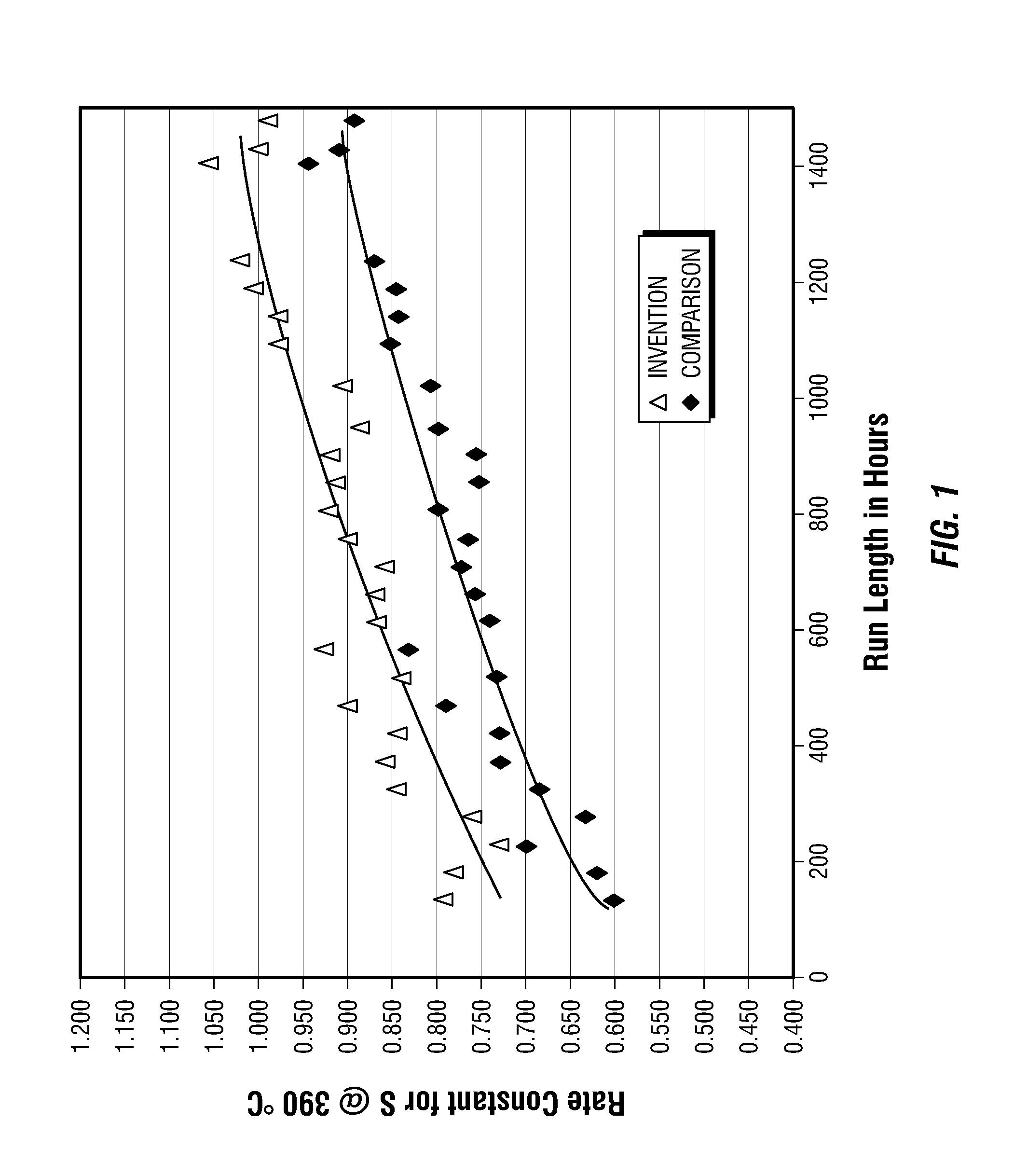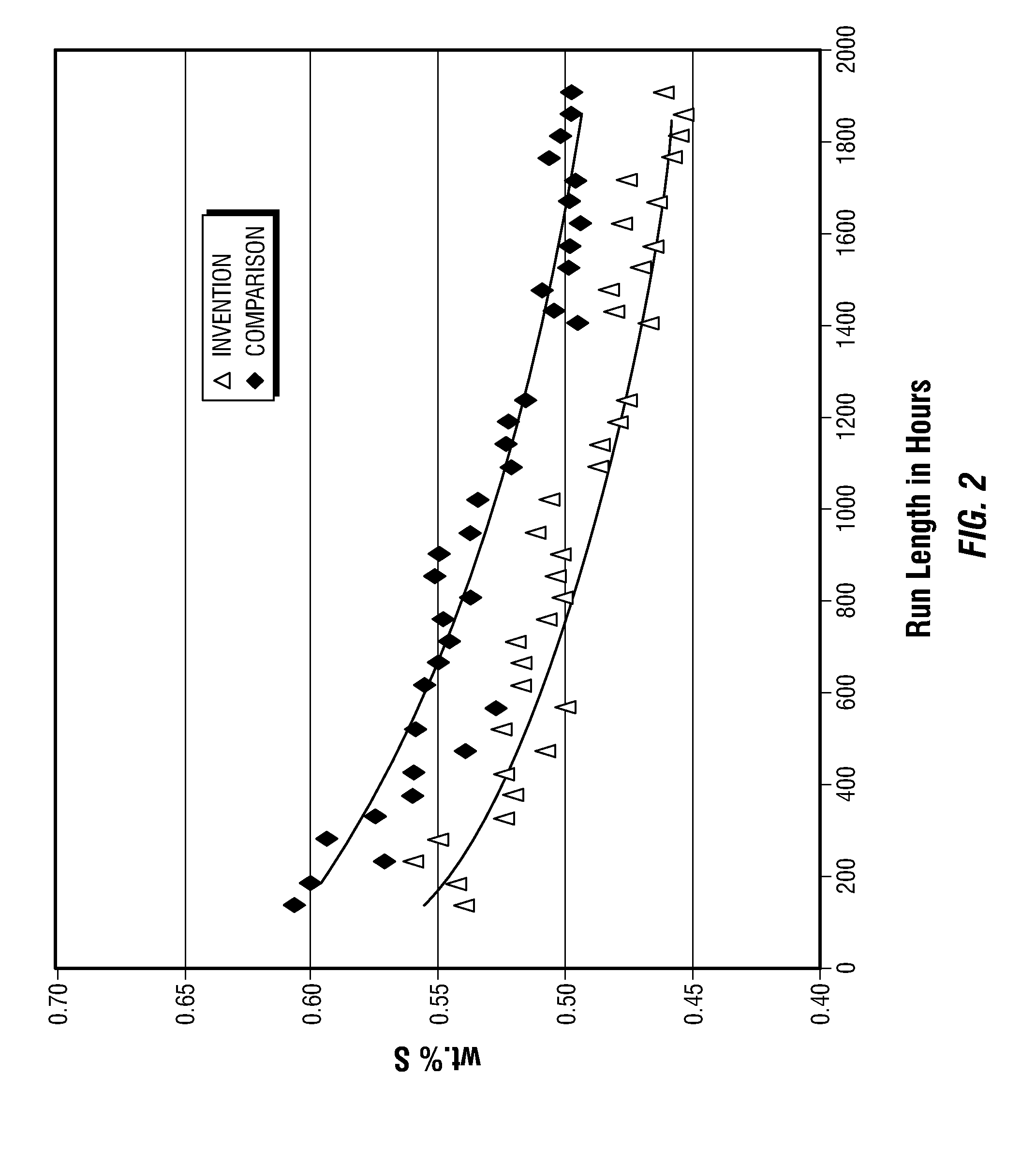Self-activating hydroprocessing catalyst having enhanced activity and self-activation characteristics and its use for treating resid feedstocks
a hydroprocessing catalyst and self-activation technology, which is applied in the direction of catalyst activation/preparation, metal/metal-oxide/metal-hydroxide catalyst, physical/chemical process catalyst, etc., can solve the problem that heavy hydrocarbon feedstocks such as vacuum tower bottoms and resids are typically more difficult to hydrotreat to remove such components as sulfur, nitrogen, metals and carbon
- Summary
- Abstract
- Description
- Claims
- Application Information
AI Technical Summary
Benefits of technology
Problems solved by technology
Method used
Image
Examples
example i
[0083]The following Table 1 presents certain properties of the dried and calcined extrudate particles.
TABLE 1Properties of Calcined ParticleProperties 788° C.Calcination Temperature(1450° F.)MoO311.85NiO2.75Hg Pore Size Dist. (Angstroms)percent 0.18 70-1004.76100-13035.96130-15026.26150-20019.04200-2403.53240-3003.00300-3501.23350-4501.59450-6001.23 600-10001.061000-50001.23>50000.88Total Pore Volume, cc / g0.66Medium Pore Diameter, Å124
example ii
[0084]This Example II describes the treatment of the calcined particle of Example I with a sulfoxide compound (DMSO) and a polysulfide compound (di-tert-nonyl polysulfide). Comparative performance data for the treated catalysts is presented in Example III.
[0085]The calcined particle of Example I was loaded into a 1.5875 cm (⅝ inch) ID by 127 cm (50 inch) stainless steel tube reactor. The tube reactor was equipped with thermocouples placed in a 0.635 cm (¼ inch) thermowell inserted concentrically into the catalyst bed, and the reactor tube was held within a 132 cm (52 inch) long 5-zone furnace with each of the zones being separately controlled based on a signal from a thermocouple.
[0086]The bed of the calcined particle of Example I was loaded into a reactor vessel into which hydrogen gas was introduced. The reactor was maintained at a pressure of 1900 psig. A straight run diesel feedstock spiked with a concentration of either dimethylsulfoxide (DMSO) or di-tert-nonyl polysulfide, dep...
example iii
[0087]This Example III describes the use of the two sulfided catalysts of Example II in the desulfurization hydrotreatment of a heavy feedstock and presents associated catalyst activity data per age of the catalyst.
[0088]After the calcined particles were treated with the sulfur-containing compounds as described above, a heavy hydrocarbon residue feedstock was then charged to the reactor. The heavy hydrocarbon feedstock was charged to the reactor along with hydrogen gas. The reactor was maintained at a pressure of 1900 psig and the feedstock was charged to the reactor at a rate so as to provide a liquid hourly space velocity (LHSV) of 1.00 hr-1 and the hydrogen was charged at a rate of 4,000 SCF / bbl. The temperature of the reactor was set at 371° C. (700° F.).
[0089]The distillation properties of the heavy hydrocarbon feedstock as determined by ASTM Method D 7169 are presented in Table 2. Other properties of the heavy hydrocarbon feedstock are presented in Table 3.
TABLE 2Distillation ...
PUM
| Property | Measurement | Unit |
|---|---|---|
| temperature | aaaaa | aaaaa |
| weight ratio | aaaaa | aaaaa |
| temperature | aaaaa | aaaaa |
Abstract
Description
Claims
Application Information
 Login to View More
Login to View More - R&D
- Intellectual Property
- Life Sciences
- Materials
- Tech Scout
- Unparalleled Data Quality
- Higher Quality Content
- 60% Fewer Hallucinations
Browse by: Latest US Patents, China's latest patents, Technical Efficacy Thesaurus, Application Domain, Technology Topic, Popular Technical Reports.
© 2025 PatSnap. All rights reserved.Legal|Privacy policy|Modern Slavery Act Transparency Statement|Sitemap|About US| Contact US: help@patsnap.com


